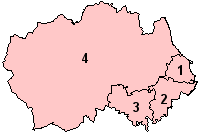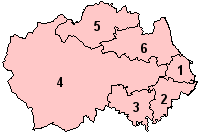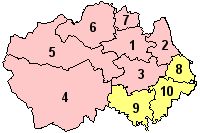County Durham
|
|
| County Durham | |
|---|---|
| Missing image EnglandDurham.png Image:EnglandDurham.png | |
| Geography | |
| Status: | Both ceremonial and administrative, though the latter is smaller. |
| Region: | North East England |
| Area: - Total - Admin. council - Admin. area | Ranked 19th 2,676 km² Ranked 23rd 2,226 km² |
| Admin HQ: | Durham |
| ISO 3166-2: | GB-DUR |
| ONS code: | 20 |
| NUTS 3: | UKC14 |
| Demographics | |
| Population: - Total (2003 est.) - Density - Admin. council - Admin. pop. | Ranked 23rd 868,813 319 / km² Ranked 27th 494,159 |
| Ethnicity: | 98.6% White |
| Politics | |
 Durham County Council http://www.durham.gov.uk/ | |
| Executive: | Labour |
| Members of Parliament | |
|
Hilary Armstrong, Roberta Blackman-Woods, Tony Blair, Frank Cook, John Cummings, Helen Goodman, Kevan Jones, Alan Milburn, Dari Taylor, Iain Wright | |
| Districts | |
* Only the part of the borough to the north of the River Tees is within the ceremonial County Durham. | |
County Durham is a county in north-east England. Its county town is Durham. It is a county of contrasts: the remote and sparsely populated dales and moors of the Pennines characterise the interior; while nearer the coast the county is highly urbanised, and was once dominated by the coal mining industry.
| Contents |
The name
The form of the county name is unique in England. Many counties are named after their principal town, but the expected form here would be Durhamshire. The reason it is called County Durham instead is that the Prince-Bishops of Durham historically exercised power in regions outside the county as well, so the inner part was named County Durham as opposed to the rest of the estate of Durham. Note that the form County X is standard for Irish counties, with no such significance.
Geographical extent
County Durham is roughly bounded by the watershed of the Pennines in the west, the River Tees in the south, the North Sea in the east and the Rivers Tyne and Derwent in the north. The name County Durham, however, is used to refer to three distinct entities: the traditional, ceremonial, and administrative counties.
Traditional county
The county traditionally extends to the south bank of the River Tyne and includes Sunderland, South Shields, and Gateshead. It borders the counties of Cumberland, Northumberland, Westmorland and Yorkshire. The east of the county between the Ryhope district of Sunderland and Seaton Carew in Hartlepool is the coastline of the North Sea. Several exclaves have existed in the county's history, including Bedlingtonshire, Norhamshire, Islandshire (incorporated into Northumberland in 1844), and Crayke, now in North Yorkshire. Startforth Rural District is traditionally part of the North Riding of Yorkshire. The modern unitary authorities of Hartlepool, Darlington, and Stockton-on-Tees are part of the traditional County Durham.
Ceremonial county
Durham County Council was established along with all the other English county councils in 1888. Major local government reorganisation on 1 April 1974 created the metropolitan boroughs of Sunderland, South Tyneside and Gateshead out of County Durham into the newly established county of Tyne and Wear. At the same time, the new county of Cleveland took out Stockton-on-Tees and Hartlepool. County Durham did however gain the rural district of Startforth south of the River Tees near to Barnard Castle. Since then, Cleveland has been abolished, but Stockton-on-Tees and Hartlepool have not been returned to Durham, except for the purposes of Lord-Lieutanancy. County Durham borders on the ceremonial counties of North Yorkshire, Cumbria, Northumberland and Tyne and Wear.
Administrative county
The present Durham County Council administers the area of the ceremonial county, with the exception of Hartlepool, Darlington, and Stockton-on-Tees, which are unitary authorities.
The county is divided into seven local government districts, they are:
- The City of Durham
- Easington, including the new town of Peterlee.
- Sedgefield, including Spennymoor.
- Teesdale, including Barnard Castle and the villages of Teesdale, including the former Startforth Rural District.
- Wear Valley, including Crook, Bishop Auckland and Willington, and the villages along Weardale.
- Derwentside, including Consett and Stanley.
- Chester-le-Street, including Sacriston.
On 1 April 1997, the town of Darlington with its population of 100,000 became a unitary authority and thus separate from County Durham. It continues to share a police and fire service with the county.
Options for change
In May 2004 options for regional government were published which, if adopted, would have resulted in the removal of four of the districts from Durham County Council's jurisdiction to form two unitary authorities, and the abolition of the three remaining borough councils to make County Durham a unitary authority in its own right. This did not eventually occur.
On 4 November 2004 a referendum was held on proposals to introduce an elected regional assembly for the North East of England. At the same time as this, the electorate was asked to choose between two options for the organisation of local government below the regional tier. The assembly proposal was rejected overwhelmingly, making the question of unitary authorities in County Durham moot. For further information on the assembly referendum, see Northern England referendums, 2004.
For County Durham the options were:
- a single authority for the existing County Council area
- three authorities for the existing County Council area
| Option 1 | Option 2 |

| 
|
Settlements
For a complete list of settlements see list of places in County Durham.
This is an list of the main towns in County Durham. The area covered is the entire ceremonial county, hence the inclusion of towns which are no longer administered by Durham County Council.
- Barnard Castle, Billingham, Bishop Auckland
- Chester-le-Street, Consett
- Darlington, Durham
- Eaglescliffe, Easington
- Ferryhill
- Hartlepool
- Newton Aycliffe
- Peterlee
- Seaham, Sedgefield, Spennymoor, Stanley, Stockton-on-Tees
- Willington
Places of interest
- Auckland Castle, Bishop Auckland Missing image
HH_icon.png
Historic house
- Barnard Castle Missing image
EH_icon.png
English Heritage
Missing image
HH_icon.png
Historic house
- Beamish museum in Stanley Missing image
UKAL_icon.png
Accessible open space
Missing image
Museum_icon_(red).png
Museum (charges for entry)
Missing image
HR_icon.png
Heritage railway
- Bowes Museum in Barnard Castle Missing image
Museum_icon_(red).png
Museum (charges for entry)
Missing image
HH_icon.png
Historic house
- Durham Cathedral and Castle, a World Heritage Site
- Escomb Saxon Church, near Bishop Auckland
- Finchale Priory, near Durham city Missing image
EH_icon.png
English Heritage
- High Force and Low Force waterfalls on the River Tees Missing image
UKAL_icon.png
Accessible open space
- Raby Castle, near Staindrop
- Tanfield Railway in Tanfield Missing image
HR_icon.png
Heritage railway
External links
- Durham County Council (http://www.durham.gov.uk)
- Information on County Durham (http://www.britishcounties.info/durham/)
| United Kingdom | England | Ceremonial counties of England | 
|
|
Bedfordshire | Berkshire | City of Bristol | Buckinghamshire | Cambridgeshire | Cheshire | Cornwall | Cumbria | Derbyshire | Devon | Dorset | Durham | East Riding of Yorkshire | East Sussex | Essex | Gloucestershire | Greater London | Greater Manchester | Hampshire | Herefordshire | Hertfordshire | Isle of Wight | Kent | Lancashire | Leicestershire | Lincolnshire | City of London | Merseyside | Norfolk | Northamptonshire | Northumberland | North Yorkshire | Nottinghamshire | Oxfordshire | Rutland | Shropshire | Somerset | South Yorkshire | Staffordshire | Suffolk | Surrey | Tyne and Wear | Warwickshire | West Midlands | West Sussex | West Yorkshire | Wiltshire | Worcestershire |

